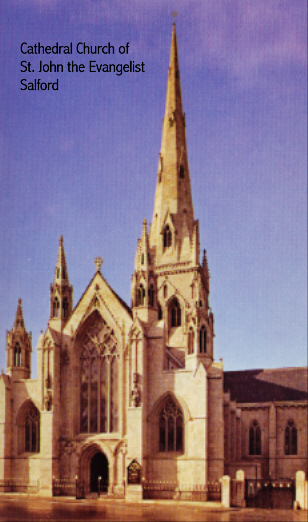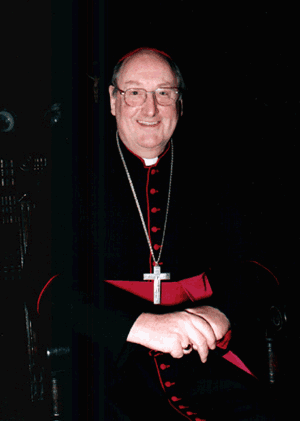This page is dedicated to the Cathedral Church of
St John the Evangelist, Chapel Street, Salford. I was
given permission to publish this by Fr. Brendan
Curley, Administrator of the Cathedral so I hope this
meets with his approval.
In June 1890, St
John's Cathedral (picture) , the Mother
Church of the Salford Diocese, was solemnly
consecrated by the second Bishop of Salford, Herbert
Vaughan. Forty-six years earlier in 1844, the
foundation stone had been laid by Dr. James Sharples,
Co-adjutor Bishop to George Brown of the Lancaster
Vicariate. The church was blessed and opened for
divine worship by Bishop Nicholas Wiseman of London,
but the most solemn liturgical rite of consecration
had to be deferred for 42 years until the immense
capital debt had been paid.
The church is a remarkable tribute to the vision
and faith of the founding fathers who planned and
commissioned this great edifice more than one hundred
and fifty years ago.
Designed to take its place among the great
cathedrals of our day, St John's is remarkably
faithful to pre-reformation traditions. Mr. Matthew
Hadfield, the architect, drew inspiration from some
of the great churches built in the ages of faith. The
West Door is a copy of the West Front of Howden
Church in Yorkshire; The Choir
(picture) and Sanctuary(picture)
are a replica of the handsome Abbey Church of Selby;
the decorations of the groined roof are copied from
the church of St Jacques at Liege; the delicate
steeple, the tallest spire in Lancashire, is
reminiscent of the ancient church at Newark in
Nottinghamshire.
All in all, it is a symphony of line and colour,
of aesthetic inspiration and of functional
effectiveness harmoniously blended. Small wonder that
it commands the admiration of the citizens of Salford
for its stirring beauty and bold designs.
Cathedrals are built to declare before men the
mighty things of God. If a day should dawn when we
cease to create these monuments of faith, the Faith
itself will be in jeopardy. As long as the urge to
build cathedrals remains as strong and stronger than
the desire to build Towers of Babel or munition
factories then we can be assured oof the enduring
vigour of the spirit of man.
Cathedrals are built not only of steel and stone.
They rise out of the sacrifices and endeavours of
many generations.

Some History
The first Catholic Church in this area was
established in the year 667 about quarter of a mile
away down Chapel Street where Trinity Chuch now
stands. It lasted for nearly four hubdred years. In
1053 it was replaced by a second church which lasted
until 1384. What exactly happened to the second
church is not known. Possibly it fell into a state of
disrepair and became unsafe to use. Whatever the
reason, this particular site ceased to be a place of
worship for nearly one hundred and sixty years. A
tiny chapel was built near the present site of the
Cathedral between 1382 and 1425, partly on what is
now Ford Street and possibly on what is now the site
of Done Turf Accountants, just opposite what is now
the Church Inn! On the site where the present
baptismal font now stands, a second chapel was built
which was used between 1424 and 1535. This was also
very small, the building being less than ten yards
square.
The present day Trinity Church, originally
Catholic, was completed in 1535. In 1568 it became
Church of England and has remained so to the present
day.

The Present and Future
The importance of the Cathedral as a parish church
has declined over the years as the demolition of many
homes in the area has had its effect. A second phase
of these changes is now working through as 50's and
60's built high rise flats are also demolished. With
some rebuilding and adaptation, the congregation has
started to rise again but it will never have anything
approaching the numbers it once had.
However, as the Cathedral has declined as a parish
church, so it has grown as the Mother Church of the
Diocese. It is fitting that the Catholics of the
whole Diocese should feel a growing awareness and
attachment to this Cathedral as, in a real sense,
their own church.
The Cathedral has always been used for ceremonies
and functions which overlap parochial and deanery
boundaries. Diocesan associations of different kinds
have been drawn to the Cathedral for their important
gatherings. Such bodies as the Union of Catholic
Mothers, the Society of St Vincent de Paul, the
Catholic Stage Guild, the Rescue Society are familiar
names. Recent years have seen the spiritual life of
the Diocese becoming more and more the life of the
Cathedral itself. The emphasis for this comes from
the deeper involvement of the laity, under the
inspiration of the Bishop, in the varied levels of
Catholic life and activity.
Reflecting this are the gatherings at the
Cathedral of those active at a liturgical level,
especially Eucharistic Ministers and Readers. From a
broader pastoral level come such diocesan groups as
Justice and Peace and Marriage Encounter.
Our Catholic schools have always played a vital
role in the maintaining and developing of the Faith
in the Diocese of Salford. The Cathedral offers
itself to both sides of the educational programme.
For those on the receiving end as students, there is
the liturgical service each year for the Diocesan
Youth, as well as the special Diocesan School
Leaver's Day. At the other end of the education
spectrum is the development of sessions for the
Catholic Teachers of the Diocese. An opportunity is
now offered for Foundation Governors of all Catholic
Schools to attend a celebration arranged to assist
them in the increasing responsibilities they have to
face.
Ecumenism has become a feature of Catholic life as
a whole. This too finds a response in this Cathedral.
For those who are already proposing to come into full
communion with the Church there is their first
welcoming to what will be their Mother Church in the
future. This is the service which marks an important
stage in the Rite of Christian Initiation of Adults.
It is a point at which the Bishop in the company of
their parish priest accepts them to complete the
course of preparation.
On a more regular basis are the formal ecumenical
encounters and the Church Unity Services. An
outstanding feature is the popular Taize hour (on the
First Friday of each month at 7.30pm). This started
back in about 1983 when Father Philip Nathaniel,
(then our assistant priest at St Vincent's, Norden
and later Bishop Kelly's Secretary and now in Peru)
got together with Fr Brendan Curley of the Cathedral
and Father Terry Drainey (later serving in Africa and
now returned to England), to start these wonderful
services. (You may not I have a particular affinity
with them. This is what makes these pages
semi-official since I can put my own bits in too.)
The Cathedral also plays host more and more to Sacred
Concerts which draw audiences of mixed faiths.

The Cathedral Choir
consists of around eighteen men and women singers,
who sing each Sunday at the 11 o'clock Mass and on
other special occasions. They have a few places
available for able and experienced singers, so if
you're interested, do please get in touch with Martin Barry, the
choirmaster. His home page is here.
The Cathedral runs a choral
scholarship scheme and more details of this can be
found here.


